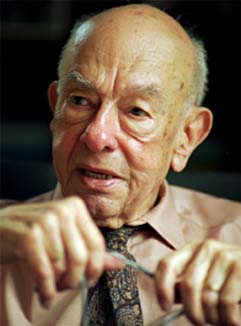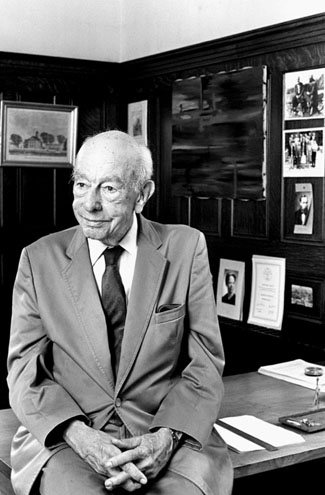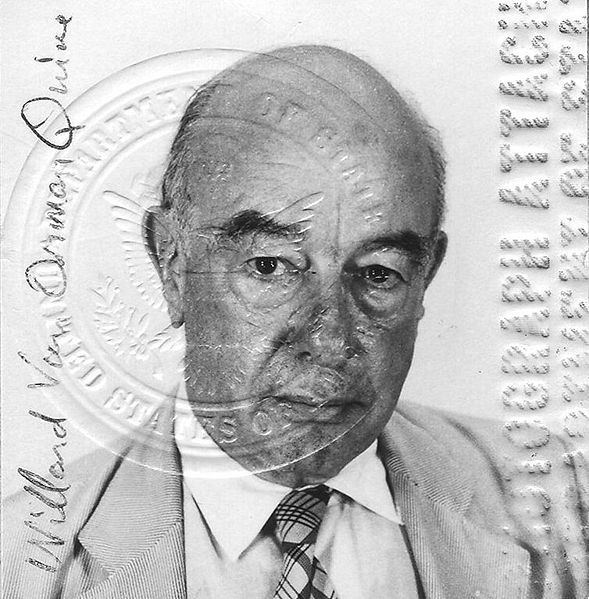<Back to Index>
- Philosopher Willard Van Orman Quine, 1908
- Architect Antoni Plàcid Guillem Gaudí i Cornet, 1852
- President of Indonesia Bacharuddin Jusuf Habibie, 1936




Willard Van Orman Quine (June 25, 1908 – December 25, 2000) (known to intimates as "Van") was an American philosopher and logician in the analytic tradition. From 1930 until his death 70 years later, Quine was continuously affiliated with Harvard University in one way or another, first as a student, then as a professor of philosophy and a teacher of mathematics, and finally as a professor emeritus who published or revised several books in retirement. He filled the Edgar Pierce Chair of Philosophy at Harvard, 1956–78. A recent poll conducted by philosophers named Quine as one of the five most important philosophers of the past two centuries.
Quine
falls squarely into the analytic philosophy tradition while also being
the main proponent of the view that philosophy is not conceptual analysis. His major writings include "Two Dogmas of Empiricism" (1951), which attacked the distinction between analytic and synthetic propositions and advocated a form of semantic holism, and Word and Object (1960), which further developed these positions and introduced the notorious indeterminacy of translation thesis. He also developed an influential naturalized epistemology that
tried to provide "an improved scientific explanation of how we have
developed elaborate scientific theories on the basis of meager sensory
input." He is also important in philosophy of science for his "systematic attempt to understand science from within the resources of science itself." This led to his famous quip that "philosophy of science is philosophy enough." According to his autobiography, The Time of My Life (1986), Quine grew up in Akron, Ohio.
His father was a manufacturing entrepreneur and his mother was a
schoolteacher. He received his B.A. in mathematics and philosophy from Oberlin College in 1930 and his Ph.D. in philosophy from Harvard University in 1932. His thesis supervisor was Alfred North Whitehead. He was then appointed a Harvard Junior Fellow,
which excused him from having to teach for four years. During the
academic year 1932–33, he travelled in Europe thanks to a Sheldon
fellowship, meeting Polish logicians (including Alfred Tarski) and members of the Vienna Circle (including Rudolf Carnap). It was through Quine's good offices that Alfred Tarski was invited to attend the September 1939 Unity of Science Congress in Cambridge. To attend that Congress, Tarski sailed for the USA on the last ship to leave Gdańsk before the Third Reich invaded
Poland. Tarski survived the war and worked another 44 years in the USA.
During World War II, Quine lectured on logic in Brazil, in Portuguese,
and served in the United States Navy in a military intelligence role, reaching the rank of Lieutenant Commander. At Harvard, Quine helped supervise the Harvard theses of, among others, Donald Davidson, David Lewis, Daniel Dennett, Gilbert Harman, Dagfinn Føllesdal, Hao Wang, Hugues LeBlanc and Henry Hiz. For the academic year 1964-1965, Quine was a Fellow on the faculty in the Center for Advanced Studies at Wesleyan University. Quine had four children by two marriages. Guitarist Robert Quine was his nephew. Quine
was politically conservative, but the bulk of his writing was in
technical areas of philosophy removed from direct political issue. He did, however, argue at points for several conservative positions: a defense of moral censorship; an argument in favor of limitations on democratic civil rights; a general defense of the status quo against efforts to remodel society by 'underprivileged groups'; an argument against publicly funded education. Quine, like many philosophers in the Anglo-American "analytic" tradition, was critical of Jaques Derrida; in 1992, Quine led an unsuccessful petition to stop Cambridge University from
granting Derrida an honorary degree. According to Derrida, Quine
believed that Derrida's work tried to "politicize and democratize the
university scene". Quine regarded Derrida's work as pseudo-philosophy
or sophistry. Quine's Ph.D. thesis and early publications were on formal logic and set theory. Only after WWII did he, by virtue of seminal papers on ontology, epistemology and
language, emerge as a major philosopher. By the 1960s, he had worked
out his "naturalized epistemology" whose aim was to answer all
substantive questions of knowledge and meaning using the methods and
tools of the natural sciences. Quine roundly rejected the notion that
there should be a "first philosophy", a theoretical standpoint somehow
prior to natural science and capable of justifying it. These views are
intrinsic to his naturalism. Quine
often wrote superbly crafted and witty English prose. He had a gift for
languages and could lecture in French, Spanish, Portuguese and German.
But like the logical positivists, he evinced little interest in the
philosophical canon: only once did he teach a course in the history of
philosophy, on Hume. In the 1930s and 40s, discussions with Rudolf Carnap, Nelson Goodman and Alfred Tarski,
among others, led Quine to doubt the tenability of the distinction
between "analytic" statements — those true simply by the meanings of
their words, such as "All bachelors are unmarried" — and "synthetic"
statements, those true or false by virtue of facts about the world,
such as "There is a cat on the mat." This distinction was central to logical positivism. Although Quine's criticisms played a major role in the decline of logical positivism, he remained a verificationist,
to the point of invoking verificationism to undermine the
analytic-synthetic distinction. As a verificationist, he drew on
several sources including his Harvard colleague B.F. Skinner, and particularly on his analysis of language in Verbal Behavior. Quine was a major editor of the journal Behaviorism. Like other analytic philosophers before him, Quine accepted the definition of "analytic" as "true in virtue of meaning alone". Unlike them, however, he concluded that ultimately the definition was circular.
In other words, Quine accepted that analytic statements are those that
are true by definition, then argued that the notion of truth by
definition was unsatisfactory. Quine's chief objection to analyticity is with the notion of synonymy (sameness
of meaning), a sentence being analytic, just in case it substitutes a
synonym for one "black" in a proposition like "All black things are
black" (or any other logical truth).
The objection to synonymy hinges upon the problem of collateral
information. We intuitively feel that there is a distinction between
"All unmarried men are bachelors" and "There have been black dogs", but
a competent English speaker will assent to both sentences under all
conditions since such speakers also have access to collateral information bearing
on the historical existence of black dogs. Quine maintains that there
is no distinction between universally known collateral information and
conceptual or analytic truths. Another approach to Quine's objection to
analyticity and synonymy emerges from the modal notion of logical possibility. A traditional Wittgensteinian view
of meaning held that each meaningful sentence was associated with a
region in the space of possible worlds. Quine finds the notion of such
a space problematic, arguing that there is no distinction between those
truths which are universally and confidently believed and those which
are necessarily true. The central theses underlying the indeterminacy of translation and other extensions of Quine's work are ontological relativity and the related doctrine of confirmation holism. The premise of confirmation holism is
that all theories (and the propositions derived from them) are
under-determined by empirical data (data, sensory-data, evidence);
although some theories are not justifiable, failing to fit with the
data or being unworkably complex, there are many equally justifiable
alternatives. While the Greeks' assumption that (unobservable) Homeric
gods exist is false, and our supposition of (unobservable)
electromagnetic waves is true, both are to be justified solely by their
ability to explain our observations. Quine's ontological relativism led him to agree with Pierre Duhem that for any collection of empirical evidence, there would always be many theories able to account for it. However, Duhem's holism is much more restricted and limited than Quine's. For Duhem, underdetermination applies only to physics or possibly to natural science, while for Quine it applies to all of human knowledge. Thus, while it is possible to verify or falsify whole
theories, it is not possible to verify or falsify individual
statements. Almost any particular statements can be saved, given
sufficiently radical modifications of the containing theory. For Quine,
scientific thought forms a coherent web
in which any part could be altered in the light of empirical evidence,
and in which no empirical evidence could force the revision of a given
part. Quine's writings have led to the wide acceptance of instrumentalism in the philosophy of science. The problem of non-referring names is an old puzzle in philosophy, which Quine captured eloquently when he wrote, "A
curious thing about the ontological problem is its simplicity. It can
be put into three Anglo-Saxon monosyllables: 'What is there?' It can be
answered, moreover, in a word—'Everything'—and everyone will accept
this answer as true." More directly, the controversy goes, "How can we talk about Pegasus?
To what does the word 'Pegasus' refer? If our answer is, 'Something,'
then we seem to believe in mystical entities; if our answer is,
'nothing', then we seem to talk about nothing and what sense can be
made of this? Certainly when we said that Pegasus was a mythological
winged horse we make sense, and moreover we speak the truth! If we
speak the truth, this must be truth about something. So we cannot be speaking of nothing." Quine
resists the temptation to say that non-referring terms are meaningless
for reasons made clear above. Instead he tells us that we must first
determine whether our terms refer or not before we know the proper way
to understand them. However, Czeslaw Lejewski criticizes
this belief for reducing the matter to empirical discovery when it
seems we should have a formal distinction between referring and
non-referring terms or elements of our domain. He writes further, "This
state of affairs does not seem to be very satisfactory. The idea that
some of our rules of inference should depend on empirical information,
which may not be forthcoming, is so foreign to the character of logical
inquiry that a thorough re-examination of the two inferences
[existential generalization and universal instantiation] may prove
worth our while." He then goes on to offer a description of free logic,
which he claims accommodates an answer to the problem. Lejewski then
points out that free logic additionally can handle the problem of the
empty set. Quine had considered the problem of the empty set
unrealistic, which left Lejewski unsatisfied. Over
the course of his career, Quine published numerous technical and
expository papers on formal logic, some of which are reprinted in his Selected Logic Papers and in The Ways of Paradox. Quine confined logic to classical bivalent first-order logic, hence to truth and falsity under any (nonempty) universe of discourse. Hence the following were not logic for Quine: Quine wrote three undergraduate texts on logic: Elementary Logic, Methods of Logic and Philosophy of Logic. Mathematical Logic is based on Quine's graduate teaching during the 1930s and 40s. It shows that much of what Principia Mathematica took more than 1000 pages to say can be said in 250 pages. The proofs are concise, even cryptic. The last chapter, on Gödel's incompleteness theorem and Tarski's indefinability theorem, along with his article of 1946, became a launching point for Raymond Smullyan's
later lucid exposition of these and related results. Quine's work in
logic gradually became dated in some respects. Techniques he did not
teach and discuss include analytic tableaux, recursive functions, and model theory. His treatment of metalogic left something to be desired. For example, Mathematical Logic does not include any proofs of soundness and completeness.
Early in his career, the notation of his writings on logic was often
idiosyncratic. His later writings nearly always employed the now-dated
notation of Principia Mathematica. Set against all this are the simplicity of his preferred method (as exposited in his Methods of Logic)
for determining the satisfiability of quantified formulas, the richness
of his philosophical and linguistic insights, and the fine prose in
which he expressed them. Most of Quine's original work in formal logic from 1960 onwards was on variants of his predicate functor logic, one of several ways that have been proposed for doing logic without quantifiers. Quine
was very warm to the possibility that formal logic would eventually be
applied outside of philosophy and mathematics. He wrote several papers
on the sort of Boolean algebra employed in electrical engineering, and with Edward J. McCluskey, devised the Quine–McCluskey algorithm of reducing Boolean equations to a minimum covering sum of prime implicants. While his contributions to logic include elegant expositions and a number of technical results, it is in set theory that
Quine was most innovative. He always maintained that mathematics
required set theory and that set theory was quite distinct from logic.
He flirted with Nelson Goodman's nominalism for a while, but backed away when he failed to find a nominalist grounding of mathematics. Over the course of his career, Quine proposed three variants of axiomatic set theory, each including the axiom of extensionality: All three set theories admit a universal class, but since they are free of any hierarchy of types, they have no need for a distinct universal class at each type level. Quine's
set theory and its background logic were driven by a desire to minimize
posits; each innovation is pushed as far as it can be pushed before
further innovations are introduced. For Quine, there is but one
connective, the Sheffer stroke, and one quantifier, the universal quantifier. All polyadic predicates can be reduced to one dyadic predicate, interpretable as set membership. His rules of proof were limited to modus ponens and substitution. He preferred conjunction to either disjunction or the conditional,
because conjunction has the least semantic ambiguity. He was delighted
to discover early in his career that all of first order logic and set
theory could be grounded in a mere two primitive notions: set abstraction and inclusion.
Just as he challenged the dominant analytic-synthetic distinction, Quine also took aim at traditional normative epistemology.
According to Quine, normative epistemology is the trend that assigns
ought claims to conditions of knowledge. This approach, he argued, has
failed to give us any real understanding of the necessary and
sufficient conditions for knowledge. Quine recommended that, as an
alternative, we look to natural sciences like psychology for a full
explanation of knowledge. Thus, we must totally replace our entire
epistemological paradigm. Quine's proposal is extremely controversial
among contemporary philosophers and has several important critics, with Jaegwon Kim the most prominent among them.